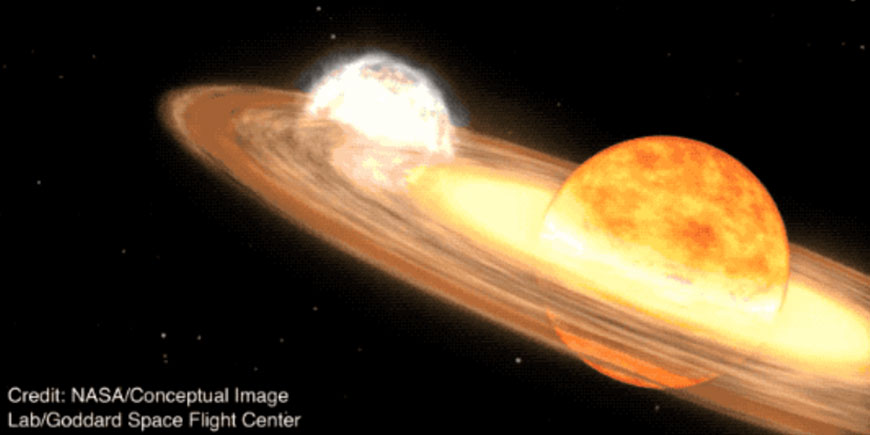It is expected that a stellar explosion, which appears in the sky every 80 years, will take place between now and September.
Situated at a distance of about 3,000 light-years away the star system T Coronae Borealis, or T Cr B, is likely to explode. If the star explodes, it will be visible to the naked eye here on Earth.
A once-in-a-lifetime opportunity
There are cosmic events that only happen once in a lifetime, and we have the good fortune to be witnesses to one of them.
The white dwarf of the binary system T Coronae Borealis (T CrB), in the constellation Corona Borealis, is about to explode as a nova after a good 80 years since its last outburst and could be visible to the naked eye.
The event is scheduled to take place between February and September 2024.
What is Nova?
A nova is the sudden, brief explosion from a collapsed star known as a white dwarf, that remains intact and keeps on releasing material in a repetitive cycle. It can occur for thousands of years. As with all stellar reactions, the phenomenon causes a sudden increase in the brightness of a star already visible to the naked eye, or the appearance of a new star (Latin nova) previously invisible to the naked eye.
When a nova appears in the sky, it is possible to see an increase in the light at the point where the explosion has taken place. Depending on the size of the event and how far away it is, it can be observed with the naked eye or with the help of hand-held telescopes. So even though the brightness of the binary system is not normally bright enough to be detected, the 2024 T CrB nova will be visible from Earth.
This phenomenon is not to be confused with a supernovae, which is the explosive death of a massive star. Supernovae can destroy nearby planets, or create other objects such as black holes and neutron stars.
T Coronae Borealis nova
T Coronae Borealis is part of the constellation Corona Borealis, which in turn borders Hercules and Boote. The system is about 2600 light-years from Earth (the distance light travels in a year, or about 9000 billion kilometres) and consists of two stars orbiting each other with very different characteristics.

One of these is a red giant, a star that has used up all the hydrogen in its core and sustains itself by nuclear fusion of hydrogen in a shell surrounding the inert helium core. Its mass is 0.7 times that of the Sun, but its radius and luminosity are 66 and 620 times larger, respectively. Its surface temperature is about 3500°C, which is the reason for its red colour.
The other component of the binary system is a white dwarf, which is the final stage in the life of a star with a mass similar to that of our Sun. The mass of the white dwarf T Coronae Borealis is estimated to be around 1.2 times the mass of the sun.
The two stars are very close to each other in astronomical terms, separated by about 0.5 astronomical units, or half the average distance between the Earth and the Sun (or about 150 million kilometres). The close proximity and the strong gravitational attraction between them mean that there is an exchange of matter between the two of them.
This is a very peculiar system, known as a ‘recurrent nova‘: the red giant becomes unstable from its increasing temperature and pressure and begins ejecting its outer layers, the white dwarf collects that matter onto its surface.
One star explosion every 80 years
T CrB’s nova was not formally discovered until 1866, but there are records of its appearance in the region in 1217 and 1787.
‘Every eighty years or so, the white dwarf’s dense, shallow atmosphere eventually heats up enough to trigger an uncontrolled thermonuclear reaction, resulting in the brilliant explosion visible even from Earth,’ explains Nasa.
At its peak, the star will be visible to the naked eye for several days, and with binoculars for just over a week, before fading for another 80 years.
Normally this binary system is not visible to the naked eye, but the thermonuclear explosion that will be triggered on the surface of the white dwarf of the binary system will make this star as bright as the North Star.
‘This could be a once-in-a-lifetime opportunity,’ said NASA.
This NASA concept animation shows the explosion of the nova in T Coronae Borealis:

When and how the explosion can be observed
There’s just one small problem: it’s not known exactly when it’s going to explode. The phenomenon is still too unpredictable to set a specific date, and only when the process begins will it be possible to calculate the moment of maximum brightness of the explosion. The only confirmed information is that T Corona Borealis could have an explosion any time between now and September 2024.
So all that remains to be done is to wait for further news before setting out in search of this anomalous glow in the night sky.
To find the Corona Borealis, it is enough to find the largest constellations of Hercules (the fifth largest in the sky) and Boote: the new star will appear in the middle of these two groups of stars. The constellation is clearly visible in the spring and summer skies, rising in the east at the end of February, then appearing high in the sky in May and June, reaching its maximum height above the horizon in July. So if the explosion happened this month, it would be perfect!
Here is a map that shows (with a red circle) the exact location of T Coronae Borealis:



